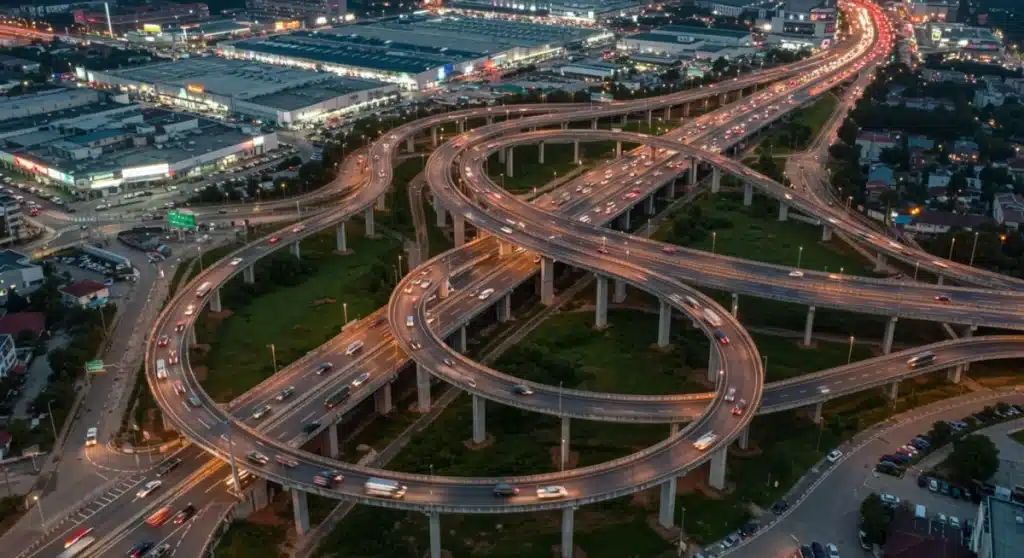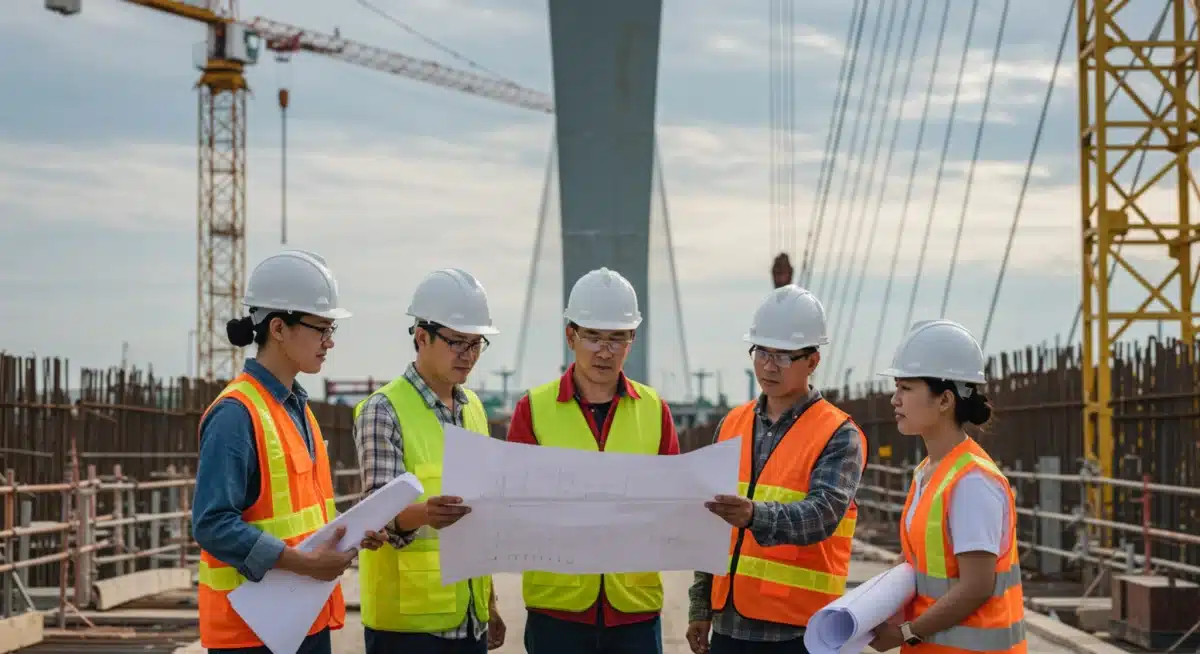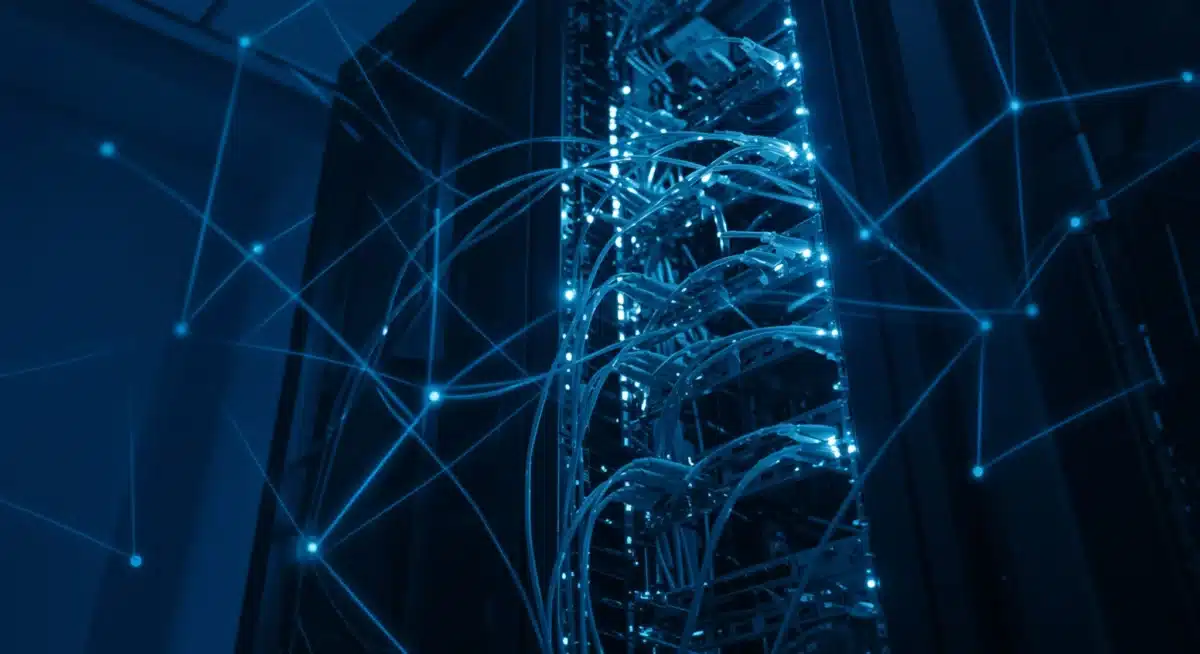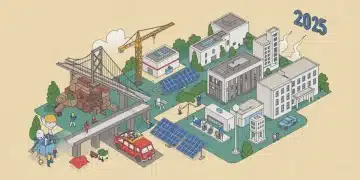Decoding the Infrastructure Bill’s Impact on US Economic Growth by 2026

The new US Infrastructure Bill is poised to significantly influence the nation’s economic trajectory by 2026, driving growth through substantial investments in vital sectors like transportation, broadband, and clean energy, fostering job creation and enhancing global competitiveness.
Have you ever wondered how monumental legislation truly reshapes a nation’s future? We’re about to delve into just that, by decoding the impact of the new Infrastructure Bill on US economic growth by 2026. This landmark investment promises a ripple effect across industries, touching everything from your daily commute to the digital economy.
Understanding the Infrastructure Investment and Jobs Act
The Infrastructure Investment and Jobs Act (IIJA), signed into law in late 2021, represents a generational investment in America’s infrastructure. This bipartisan bill allocates an unprecedented amount of funding towards repairing and rebuilding roads, bridges, public transit, water pipes, broadband internet, and the electric grid. Its scope is vast, aiming to modernize critical systems that have long suffered from underinvestment.
Beyond simply fixing what’s broken, the IIJA is designed to prepare the United States for future economic challenges and opportunities. It emphasizes resilience against climate change impacts, promotes clean energy initiatives, and seeks to bridge the digital divide. The legislation’s multi-year funding structure ensures a sustained effort, with significant allocations projected to be spent and impacting the economy well into 2026 and beyond.
Key Pillars of Investment
The bill is structured around several core components, each targeting specific areas of infrastructure. These pillars are crucial for understanding the diverse ways the investment will stimulate economic activity.
- Transportation: Roads, bridges, public transit, rail, ports, and airports receive the largest share of funding, addressing decades of deferred maintenance and enhancing connectivity.
- Water Infrastructure: Significant investments are directed towards replacing lead pipes, improving water quality, and upgrading wastewater treatment facilities across the nation.
- Broadband Internet: A major focus is on expanding access to affordable, high-speed internet, especially in rural and underserved communities, recognizing its essential role in modern life and commerce.
- Power Grid and Clean Energy: Funds are allocated to modernize the electric grid, promote clean energy transmission, and invest in electric vehicle charging infrastructure.
- Environmental Remediation: Investments in cleaning up Superfund and brownfield sites, reclaiming abandoned mine lands, and plugging orphaned oil and gas wells.
The strategic allocation of these funds is not arbitrary; it targets areas identified as critical for sustained economic competitiveness and quality of life. By addressing these foundational elements, the IIJA aims to create an environment conducive to long-term prosperity.
Ultimately, the IIJA is more than just a spending package; it’s a strategic blueprint for America’s future infrastructure. Its comprehensive approach to modernizing and strengthening foundational systems is expected to yield substantial economic dividends, laying the groundwork for sustained growth and innovation.
Direct Economic Stimulus and Job Creation
One of the most immediate and tangible impacts of the Infrastructure Bill is its direct contribution to economic stimulus and job creation. The sheer volume of projects initiated by this legislation will necessitate a significant increase in labor demand across various sectors, ranging from construction and engineering to manufacturing and technology. This influx of activity is expected to provide a crucial boost to the US economy.
Economists widely agree that infrastructure spending has a high multiplier effect, meaning every dollar invested generates more than a dollar in economic activity. This is due to the interconnected nature of supply chains and the subsequent spending by those employed in infrastructure projects. The bill’s focus on domestic sourcing and labor further amplifies this effect, ensuring that the economic benefits largely remain within the national economy.

Anticipated Employment Growth
The IIJA is projected to create millions of jobs over the next decade, both directly and indirectly. Direct jobs include those in construction, engineering, and project management. Indirect jobs arise from the demand for materials, equipment, and services needed for these projects, spanning manufacturing, logistics, and raw materials extraction.
- Construction Sector Surge: A significant increase in demand for skilled tradespeople, heavy equipment operators, and construction managers.
- Manufacturing Boost: Enhanced demand for steel, concrete, machinery, and other construction materials, stimulating domestic manufacturing.
- Engineering and Design: A rise in employment for civil engineers, urban planners, and architects involved in project design and oversight.
- Emerging Green Jobs: Growth in roles related to renewable energy installation, electric vehicle infrastructure, and climate resilience projects.
These employment opportunities are not limited to a specific region but are distributed across the country, providing economic relief and stability to diverse communities. The emphasis on good-paying jobs with benefits is also a key feature, aiming to strengthen the middle class and reduce economic inequality.
Beyond the immediate creation of jobs, the long-term economic benefits include improved productivity from a more efficient infrastructure network. Reduced commute times, lower transportation costs for goods, and enhanced digital connectivity all contribute to a more dynamic and competitive economy, fostering an environment where businesses can thrive and expand, leading to further job creation.
Long-Term Productivity and Competitiveness Gains
While the immediate economic stimulus and job creation are significant, the true long-term value of the Infrastructure Bill lies in its potential to enhance US productivity and global competitiveness. Modern and efficient infrastructure is the backbone of any thriving economy, facilitating the movement of goods, people, and information, and enabling businesses to operate more effectively.
Decades of underinvestment have led to deteriorating infrastructure, resulting in bottlenecks, inefficiencies, and increased costs for businesses and consumers alike. By addressing these critical deficiencies, the IIJA aims to reduce logistical hurdles, improve supply chain resilience, and lower operational expenses for a wide range of industries. This foundational improvement is essential for the US to maintain its economic leadership on the global stage.
Boosting Business Efficiency
Improved infrastructure directly translates into greater efficiency for businesses. Faster and more reliable transportation networks mean quicker delivery times and reduced fuel costs for freight. Upgraded ports and airports streamline international trade, making US businesses more competitive in global markets.
- Reduced Transportation Costs: Better roads and transit reduce wear and tear on vehicles and decrease fuel consumption, lowering logistics expenses.
- Enhanced Supply Chain Reliability: Modernized infrastructure minimizes disruptions, ensuring a smoother flow of goods from production to market.
- Improved Access to Markets: Expanded broadband and transportation links connect businesses to new customers and suppliers, fostering growth.
Furthermore, a robust and resilient infrastructure system attracts foreign investment and encourages domestic expansion. Businesses are more likely to establish or grow operations in areas with reliable power, clean water, and efficient transportation, knowing that these foundational elements are in place to support their activities.
The investment in broadband infrastructure is particularly critical for future competitiveness. High-speed internet access is no longer a luxury but a necessity for participation in the modern economy. Expanding broadband ensures that businesses, regardless of their location, can leverage digital technologies, connect with global markets, and innovate, thereby boosting overall national productivity.
Regional Economic Disparities and Equitable Growth
A crucial aspect of the Infrastructure Bill’s impact is its potential to address longstanding regional economic disparities and promote more equitable growth across the United States. Historically, infrastructure investments have not always been evenly distributed, leading to certain regions thriving while others lagged behind due to inadequate public services and connectivity. The IIJA aims to rectify some of these imbalances.
The bill includes provisions specifically designed to direct funding to underserved communities, rural areas, and economically distressed regions. By prioritizing projects in these areas, the legislation seeks to unlock their economic potential, create local job opportunities, and improve the quality of life for residents. This targeted approach is vital for ensuring that the benefits of infrastructure modernization are broadly shared.
Targeting Underserved Communities
Many communities, particularly in rural and low-income urban areas, lack access to basic modern infrastructure, such as reliable broadband, safe drinking water, and efficient public transit. The IIJA allocates significant resources to bridge these gaps.
- Rural Broadband Expansion: Dedicated funding to extend high-speed internet to millions of Americans currently without access, fostering economic development and educational opportunities.
- Lead Pipe Replacement: Prioritizing communities with outdated water systems to ensure access to clean and safe drinking water, improving public health and equity.
- Public Transit Improvements: Investments in public transportation systems in urban and rural areas, providing better access to jobs, healthcare, and education for all residents.
By investing in these foundational services, the bill aims to create a more level playing field, allowing businesses to thrive and individuals to access opportunities regardless of their geographic location. This can help to stem the tide of rural depopulation and revitalize economically struggling regions, fostering a more balanced national economy.
Moreover, the emphasis on local hiring and small business participation in infrastructure projects further ensures that the economic benefits directly reach the communities where the work is being done. This approach empowers local economies, builds wealth within these communities, and contributes to a more inclusive and sustainable growth model for the nation as a whole.
Inflationary Pressures and Fiscal Considerations
While the economic benefits of the Infrastructure Bill are widely anticipated, it’s also important to consider the potential challenges, particularly regarding inflationary pressures and broader fiscal implications. Injecting such a large sum of money into the economy, especially during periods of high demand or supply chain constraints, can contribute to rising prices.
Economists are closely monitoring how the increased demand for construction materials, labor, and equipment might interact with existing supply-side issues. The timing of the bill’s implementation, amidst global supply chain disruptions and elevated inflation rates, introduces complexities that require careful management to mitigate adverse effects on the broader economy.
Managing Inflationary Risks
The administration and Federal Reserve are employing various strategies to manage potential inflationary impacts. These include carefully phasing in project spending, prioritizing projects that quickly alleviate supply bottlenecks, and monitoring material and labor costs.
- Phased Spending: Funds are disbursed over several years, preventing an immediate surge in demand that could overwhelm markets.
- Supply Chain Resilience: Investments aim to improve domestic manufacturing and logistics, reducing reliance on volatile international supply chains.
- Workforce Development: Programs to train and upskill workers help meet increased labor demand without substantially driving up wages due to scarcity.
The long-term benefits of improved infrastructure, such as increased productivity and reduced transportation costs, are also expected to exert downward pressure on prices over time, potentially offsetting some of the initial inflationary impulses. However, the immediate years, particularly leading up to 2026, will be critical in observing this dynamic.

From a fiscal perspective, the bill is partially funded through a combination of repurposed unspent COVID-19 relief funds, new revenue streams, and adjustments to existing programs. While the overall spending is substantial, the funding mechanisms are designed to minimize the impact on the national debt over the long term. Continuous monitoring of the fiscal health of the nation will be necessary as these investments unfold.
Environmental and Social Impacts by 2026
Beyond purely economic metrics, the Infrastructure Bill is set to deliver significant environmental and social impacts that will profoundly shape the US by 2026. The legislation contains numerous provisions aimed at addressing climate change, promoting environmental justice, and enhancing community well-being. These aspects are integral to building a more sustainable and resilient future for the nation.
Investments in clean energy, electric vehicle infrastructure, and climate resilience projects will contribute to reducing greenhouse gas emissions and mitigating the effects of extreme weather events. Concurrently, initiatives focused on environmental remediation and equitable access to resources aim to improve public health and quality of life, particularly in communities historically burdened by pollution.
Promoting Sustainability and Resilience
A significant portion of the IIJA is dedicated to fostering a greener economy and enhancing the nation’s ability to withstand environmental challenges. This includes investments in renewable energy, sustainable transportation, and protective infrastructure.
- Clean Energy Transition: Funding for clean energy transmission, grid modernization, and research into advanced energy technologies.
- Electric Vehicle Infrastructure: A nationwide network of EV charging stations to accelerate the adoption of electric vehicles, reducing reliance on fossil fuels.
- Climate Resilience: Investments in hardening infrastructure against floods, wildfires, and other climate-related disasters, protecting communities and economies.
These initiatives are expected to not only reduce the environmental footprint of the US but also create new jobs in the burgeoning green economy. By 2026, we should see tangible progress in the deployment of renewable energy sources and the expansion of sustainable transport options, contributing to a healthier planet.
Socially, the bill’s focus on replacing lead pipes, cleaning up hazardous waste sites, and expanding public transit has direct benefits for public health and equity. Ensuring access to clean water and reducing exposure to pollutants improves community well-being, while better transit options enhance access to jobs, education, and healthcare, fostering more inclusive and vibrant communities.
Challenges and Implementation Hurdles
Even with substantial funding and clear objectives, the implementation of such a massive infrastructure package is not without its challenges. The successful execution of the Infrastructure Bill by 2026 hinges on overcoming several significant hurdles, including bureaucratic complexities, labor shortages, and material supply chain issues. Addressing these challenges effectively will be crucial for realizing the full economic and social potential of the investment.
The sheer scale and decentralized nature of infrastructure projects across states and localities introduce layers of administrative complexity. Coordinating efforts, navigating regulatory frameworks, and ensuring efficient allocation of funds require robust planning and oversight. Moreover, the current economic climate, characterized by tight labor markets and persistent supply chain disruptions, adds further pressure to project timelines and budgets.
Overcoming Implementation Obstacles
Effective strategies are being developed to mitigate these challenges and ensure projects stay on track. Collaboration between federal, state, and local governments, along with private sector partnerships, is essential for streamlined execution.
- Workforce Development: Investing in training programs and apprenticeships to build a skilled labor force capable of meeting project demands.
- Supply Chain Management: Efforts to strengthen domestic manufacturing and proactively manage procurement to secure essential materials.
- Regulatory Streamlining: Initiatives to simplify permitting processes while maintaining environmental and safety standards, accelerating project approvals.
- Inter-agency Coordination: Enhancing communication and collaboration among government agencies to ensure cohesive project planning and execution.
The success of the IIJA also depends on continuous monitoring and adaptation. As projects get underway, unforeseen issues may arise, requiring flexibility and quick problem-solving. Learning from early projects and applying those lessons to subsequent phases will be vital for optimizing outcomes and maximizing the return on investment.
Ultimately, while the vision behind the Infrastructure Bill is ambitious and transformative, its real-world impact will be determined by the ability of all stakeholders to navigate these complex implementation hurdles. A concerted and collaborative effort is necessary to ensure that the promised benefits of modernized infrastructure are delivered efficiently and effectively across the United States by 2026.
| Key Economic Impact | Brief Description |
|---|---|
| Job Creation | Millions of jobs expected across construction, manufacturing, and related sectors, boosting employment. |
| Productivity Gains | Improved transportation, broadband, and utilities enhance business efficiency and reduce operational costs. |
| Equitable Growth | Targeted investments in underserved and rural areas aim to reduce regional economic disparities. |
| Inflationary Pressures | Potential for increased demand for materials and labor to contribute to short-term price increases. |
Frequently Asked Questions About the Infrastructure Bill
The primary goal is to modernize and rebuild America’s aging infrastructure, including transportation, water systems, broadband internet, and the electric grid. It aims to boost economic competitiveness, create jobs, and foster sustainable growth across the nation by addressing critical deficiencies.
By 2026, the bill is expected to create millions of jobs directly in construction, engineering, and manufacturing, and indirectly through increased demand for materials and services. This will stimulate employment across various sectors and regions, strengthening the labor market.
There is a potential for the large-scale spending to contribute to inflationary pressures, particularly if demand for materials and labor outpaces supply. However, the spending is phased, and long-term productivity gains may help mitigate some of these effects over time.
The bill invests significantly in clean energy, electric vehicle infrastructure, and climate resilience projects. These initiatives aim to reduce greenhouse gas emissions, promote sustainable transportation, and protect communities from the impacts of climate change, fostering a greener future.
The Infrastructure Bill includes targeted funding for rural and underserved communities, focusing on expanding broadband access, improving water systems, and enhancing public transit. This aims to unlock economic potential and ensure more equitable growth across all regions of the United States.
Conclusion
The Infrastructure Investment and Jobs Act represents a pivotal moment for the United States, charting a course for significant economic transformation and modernization by 2026. Through its ambitious investments in core infrastructure sectors, the bill is poised to generate substantial job growth, enhance national productivity, and foster a more competitive economy. While challenges related to implementation and potential inflationary pressures exist, the long-term benefits of a revitalized infrastructure are expected to far outweigh these hurdles. As projects unfold across the nation, we anticipate a stronger, more resilient, and equitably prosperous America, ready to meet the demands of the 21st century.





